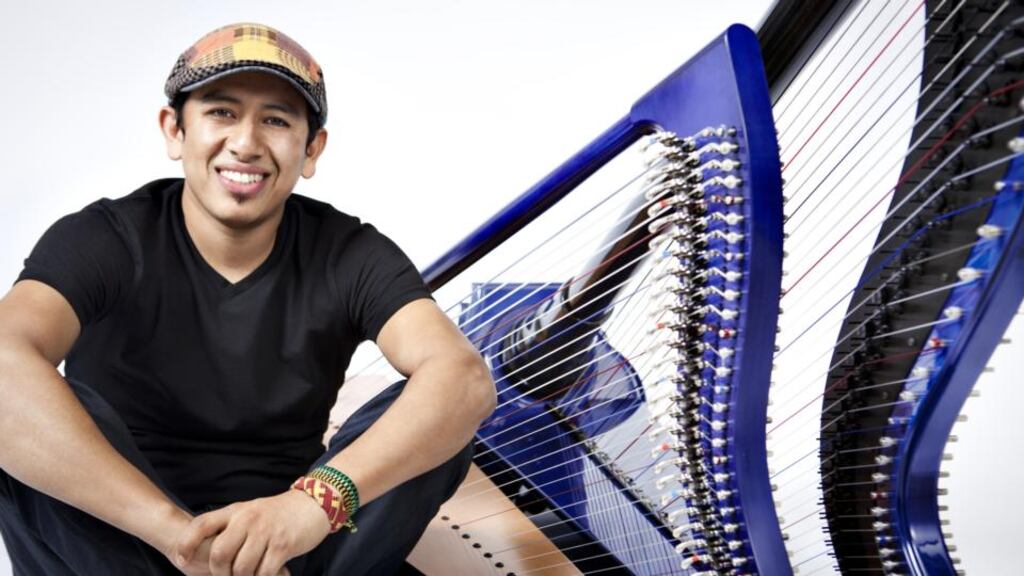Airport security being what it is these days, there are probably easier things to drag around the world than a full-sized harp. But when it comes to dealing with check-in counters, harpist Edmar Castañeda has a cheesy line that works every time. “I just walk up to the check-in desk with my big fibreglass case,” says the Colombian virtuoso, “and I smile at them and say ‘Hey, I’m an angel playing the harp, can you help me ?’”
There is something almost angelic about the way Castañeda plays the harp, making one pair of hands sound like two or three, creating intense cross-rhythms that defy expectations about such an apparently sedate instrument. It’s a virtuosity born of sustained and intense application, and one imagines a back story of childhood prodigality. But in fact, growing up poor in Bogotá, he couldn’t afford a harp; it was dancing that initially filled his head with music.
"When I was seven, my aunt Edilma told my mother about these free dance classes that were happening in the neighbourhood, and my mother enrolled my sister and I," says the harpist. "So we learned the dances of musica llanera, the traditional music of the plains of Colombia and Venezuela. That is played on the llanera harp with cuatro [a four-stringed guitar] and maracas. My aunt Edilma actually had a harp in her home, which she let me play sometimes. The first time I saw it, I said, 'Wow man, that is the instrument I want to play'."
Move to New York
When Castañeda finally got his hands on aunt Edilma's harp at the age of 13, he began to apply the rhythms and melodies he had learned in his dance lessons to his new instrument. Then, three years later, his family moved to New York, and he found himself enrolled in a Long Island high school.
“It was like a movie, man,” says Castañeda laughing, “I couldn’t speak any English, so I didn’t have a clue what was going on. I was just watching everyone else, and when they moved, I moved.”
He soon found himself playing trumpet in the school band, and, after graduation, he enrolled at Five Towns College in New York, ostensibly to study jazz trumpet. But every night, he would go to a local restaurant and play his harp to earn cash, and it was there that he began to piece together his individual hybrid of jazz and musica llanera.
“Whatever I learned during the day, I tried it out on the harp at night. Because it was a solo gig, I was forced to find a way to play all the parts. So that’s when I created this style, playing the bass lines and playing the melodies at the same time.”
Like so many New York jazz musicians, Castañeda’s big break came at a jam session. Puerto Rican guitarist Nelson Gonzalez was running a weekly jam session where anyone could get up and play. One night, a young Colombian turned up with a big white case.
“I went up to Nelson and said, ‘Hey, can I sit in ?’ and he said ‘Sure, what instrument do you play ?’ When I said ‘Harp’, he just shook his head and said, ‘Haven’t you got anything smaller?’ I said, ‘No man, but don’t worry. I have it all worked out. Just plug me in and if you like it, great. If not, I will leave’.”
Castañeda didn't leave. Instead, he became an instant member of the band and so began a career that has seen the genial Colombian go on to share the stage with jazz great Paquito D'Rivera, trumpeter Wynton Marsalis and guitarist John Scofield.
Castañeda, now 33, is on the unlikely verge of making the harp hip. His instrument, a customised harp of his own devising, is an adaptation of the traditional Colombian instrument. It allows greater harmonic flexibility, and his technical innovations have proved so successful that his design has gone into production with French harp manufacturers Camac.
“Venezuela recently ordered 20 Edmar Castañeda harps for kids to play in the music education system they have there,” he says proudly. “They sent me pictures of all these little kids playing my harp, and I thought: that’s amazing, one day I was like that.”
Proudest moment
But for all the international acclaim and the high-profile collaborations, Castañeda's proudest moment so far came when he brought his music back to Colombia and to a big auditorium in Santiago de Cali, the hometown of his aunt Edilma who, it turns out, is the real angel of the Castañeda story.
“It was an amazing moment. She was sitting at the front row, so I asked her to stand up and I let the people know that I play the harp because of her. We were both crying. She was just happy to see the results of her passion for music.”
Edmar Castañeda plays
The Sugar Club, Dublin on Sunday, then tours to Bray, Carrick-on-Shannon, Limerick, Clifden and Cork. musicnetwork.ie

















